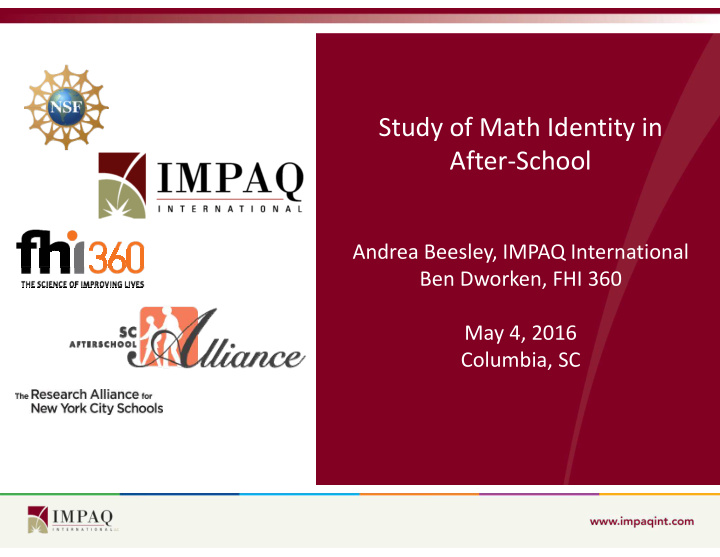



Study of Math Identity in After ‐ School Andrea Beesley, IMPAQ International Ben Dworken, FHI 360 May 4, 2016 Columbia, SC
What is Math Identity? • How students think about themselves in relation to math. • Beliefs about math ability, importance of knowing math, and challenges and opportunities in math classrooms. Recent research shows that math identity plays a crucial role in students’ decisions to engage in math learning.
Activity Information • Fun • Real world math • Inquiry ‐ based • Build essential math skills and concepts • Based on NCTM standards; meets career and college ‐ ready standards • Strategies for inclusion of all students
Activities Help Students… • Find math in everyday experiences • Improve math skills • Have positive experiences with math • Increase engagement and comprehension
Theme One: Jump Rope Math Students learn essential skills while jumping rope, having fun and exercising Create bar graphs, line graphs, scatter graphs and Venn diagrams Conduct and analyze surveys Design a math investigation
Theme Two: Built Environment Math Students learn about scale, measurement, and their built environment
Theme Three: ArtMath Students create kaleidoscopes Create art in the style of Escher and Mondrian Use tessellation, symmetry, asymmetry, and measurement
Theme Four: MusicMath Students use combinations and permutations to create music Learn about fractions through whole, half, quarter and eighth notes
Study: Participating Programs • At least 30 fourth and fifth graders, 3 group leaders , plus site coordinators • At least 90 minutes/day, 2 days/week
Study: Requirements • Four professional development sessions for group leaders – First session: Weds ‐ Thurs, July 13 ‐ 14, 2016 – Future sessions: Dec 2016, July 2017, Dec 2017 • Implement activities in 2016 ‐ 17 and 2017 ‐ 18 school years – All sites participate in PD training and implement curriculum activities – Some sites are randomly selected to do additional activities intended to improve math identity
Study: Data Collection • Group leader online survey at end of each semester (4 total over 2 years) • Student paper ‐ based surveys before program start and at end of each semester (5 total over 2 years) • Student after ‐ school program attendance records, assistance in getting academic records • Possible observations and interviews
Study: Benefits • Free professional development and curriculum materials • Program stipends for data collection and professional development • Contribute to understanding of how to develop math identity, broaden participation in STEM
References Anderson, R. (2007). Being a mathematics learner: Four faces of • identity. The Mathematics Educator, 17, 1. 7 ‐ 14. Bandura, A., Barbaranelli, C., Caprara, G. V., & Pastorelli, C. (2001). • Self ‐ efficacy beliefs as shapers of children’s aspirations and career trajectories. Child Development, 72 (91), 187–206. Boaler, J. (2002).The development of disciplinary relationships: • Knowledge, practice, and identity in mathematics classrooms. For the Learning of Mathematics, 22 (1), 42 ‐ 47. Boaler, J., William, D., & Zevenbergen, R. (2000). The construction • of identity in secondary mathematics education. Journal of Mathematical Behavior. Teacher Education. 7, 63 ‐ 86. Gee, J.P. (2001). Identity as an analytic lens for research in • education. Review of Research in Education , 25, 99 ‐ 125. Nasir, N. S. (2002). Identity, goals, and learning: Mathematics in • cultural practice. Mathematical Thinking & Learning, 4 (2/3), 213 ‐ 247.
Questions?
Study Application Form
Recommend
More recommend